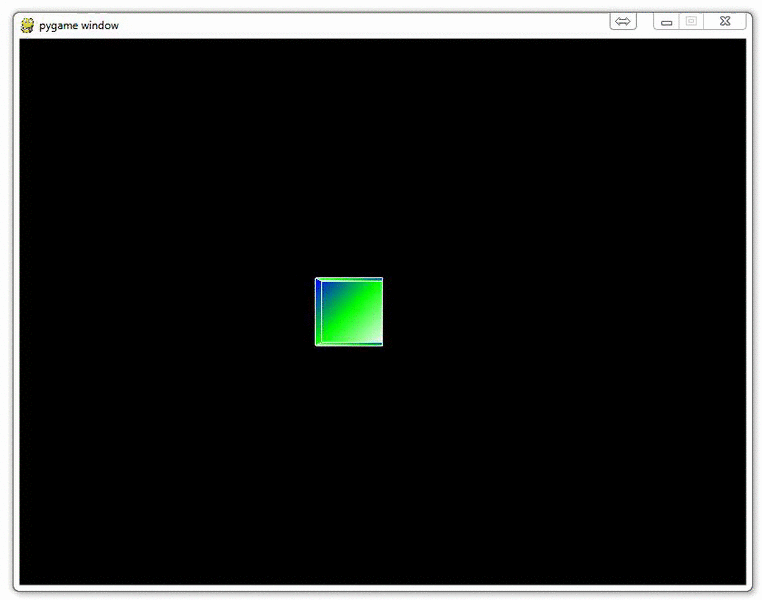
Random Cube Position
We know our end goal is to have a 3D version of the originally-2d game that we built. To do that, we need to have cubes randomly spawning in various positions, and that's what we'll be focusing on here.
In order to generate randomly, let's use the random module. Add the following import to the top of your script:
import random
Then we just need to modify our original translate a bit:
glTranslatef(random.randrange(-5,5),0, -30)
Missed something? Here's the full code up to this point:
import pygame
from pygame.locals import *
from OpenGL.GL import *
from OpenGL.GLU import *
######
import random
verticies = (
(1, -1, -1),
(1, 1, -1),
(-1, 1, -1),
(-1, -1, -1),
(1, -1, 1),
(1, 1, 1),
(-1, -1, 1),
(-1, 1, 1)
)
edges = (
(0,1),
(0,3),
(0,4),
(2,1),
(2,3),
(2,7),
(6,3),
(6,4),
(6,7),
(5,1),
(5,4),
(5,7)
)
surfaces = (
(0,1,2,3),
(3,2,7,6),
(6,7,5,4),
(4,5,1,0),
(1,5,7,2),
(4,0,3,6)
)
colors = (
(1,0,0),
(0,1,0),
(0,0,1),
(0,1,0),
(1,1,1),
(0,1,1),
(1,0,0),
(0,1,0),
(0,0,1),
(1,0,0),
(1,1,1),
(0,1,1),
)
def Cube():
glBegin(GL_QUADS)
for surface in surfaces:
x = 0
for vertex in surface:
x+=1
glColor3fv(colors[x])
glVertex3fv(verticies[vertex])
glEnd()
glBegin(GL_LINES)
for edge in edges:
for vertex in edge:
glVertex3fv(verticies[vertex])
glEnd()
def main():
pygame.init()
display = (800,600)
pygame.display.set_mode(display, DOUBLEBUF|OPENGL)
gluPerspective(45, (display[0]/display[1]), 0.1, 50.0)
#start further back
glTranslatef(random.randrange(-5,5),0, -30)
# no more rotate
#glRotatef(25, 2, 1, 0)
object_passed = False
while not object_passed:
for event in pygame.event.get():
if event.type == pygame.QUIT:
pygame.quit()
quit()
if event.type == pygame.KEYDOWN:
if event.key == pygame.K_LEFT:
glTranslatef(-0.5,0,0)
if event.key == pygame.K_RIGHT:
glTranslatef(0.5,0,0)
if event.key == pygame.K_UP:
glTranslatef(0,1,0)
if event.key == pygame.K_DOWN:
glTranslatef(0,-1,0)
'''
if event.type == pygame.MOUSEBUTTONDOWN:
if event.button == 4:
glTranslatef(0,0,1.0)
if event.button == 5:
glTranslatef(0,0,-1.0)
'''
x = glGetDoublev(GL_MODELVIEW_MATRIX)#, modelviewMatrix)
camera_x = x[3][0]
camera_y = x[3][1]
camera_z = x[3][2]
#print(camera_x,camera_y,camera_z)
# slowly move:
glTranslatef(0,0,0.5)
glClear(GL_COLOR_BUFFER_BIT|GL_DEPTH_BUFFER_BIT)
Cube()
pygame.display.flip()
if camera_z <= 0:
object_passed = True
for x in range(10000):
main()
-
OpenGL with PyOpenGL introduction and creation of Rotating Cube
-
Coloring Surfaces as well as understand some of the basic OpenGL code
-
Understanding navigation within the 3D environment via OpenGL
-
Moving the player automatically towards the cube
-
Random Cube Position
-
Adding Many Cubes to our Game
-
Adding a ground in OpenGL
-
Infinite flying cubes
-
Optimizing the processing for infinite cubes
